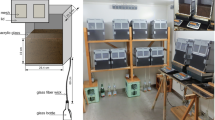Summary
Earthworm activities were observed under subdued light in lucite fronted soil filled boxes in which bean plants were growing. They formed their burrows by ingesting a relatively small core of soil about 2 mm in diameter and expanding these holes to a diameter of about 5 mm by flexing their muscles. The compacted zone extended about 4 mm from the radii of these burrows. As shallow bean roots of young plants extracted water from the upper portions of the soil, worms moved downward to moister soil. During furrow irrigation, worms moved toward the water source through existing burrows. A few of them burrowed new holes to the furrow and emerged and swam in the water for up to 20 min before burrowing back into the mud in the bottom of the furrow. In columns with sections packed with pressures of 50, 100, 200, 300 and 600 kPa, worm burrowing was reduced in sections packed at higher pressures and was practically negligible in the sections packed at 600 kPa. Visual comparison of porosity in the compacted soil surrounding earthworm burrows and the soil compacted at 300 and 600 kPa indicated that the worms are able to compact soil with a force between 300 and 600 kPa. Worms were not able to survive long enough to burrow through 15 cm of a subsoil with organic carbon content less than 0.2% that lay between them and topsoil. Both compaction and use of subsoil for the banks show promise for reducing earthworm burrowing and water loss from ditches.
Similar content being viewed by others
References
Akram M, Kemper WD, Sabey J (1981) Water levels and losses and cleaning in watercourses. Trans ASAE 24:643
Clyma W, Kemper WD, Ashraf MM (1981) Reducing farm delivery losses in pakistan. Trans ASAE 24:367
Kemper WD, Trout TJ, Segeren A, Bullock MH (1987) Hydrology and worms. Soil Water Conserv (In press)
Kladivko EJ, MacKay AD, Bradford JM (1986) Earthworms as a factor in the reduction of soil crusting. Soil Sci Soc Amer J 50:191
MacKay AD, Kladivko EJ (1985) Earthworms and breakdown of soybean and maize residues in soil. Soil Biol Biochem 16/17:851
Trout TJ, Johnson G, Segeren A (1987) Erath worms and furrow infiltration. ASAE Trans (In press)
Author information
Authors and Affiliations
Rights and permissions
About this article
Cite this article
Kemper, W.D., Jolley, P. & Rosenau, R.C. Soil management to prevent earthworms from riddling irrigation ditch banks. Irrig Sci 9, 79–87 (1988). https://doi.org/10.1007/BF00262352
Received:
Issue Date:
DOI: https://doi.org/10.1007/BF00262352




